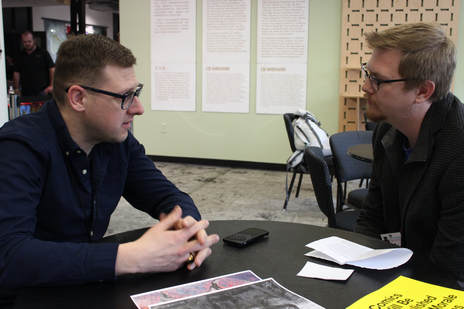Written by Joel T. Lewis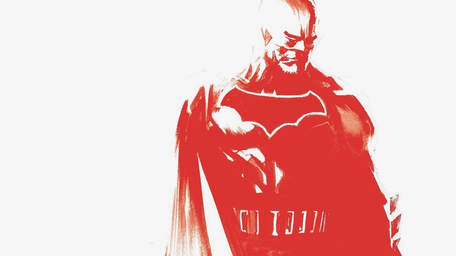 You might not believe it dear readers but I didn’t grow up reading comics. I know you probably imagine a tiny Joel swimming in a sea of old direct editions, fingers tattooed with ink from the oily, yellowing pages of Spidey, Bats, and Cap but that wasn’t the case. You would find elementary school Joel, complete with Obi-Wan Kenobi Lunchbox, walking along the fence of the school yard at lunch with his nose buried in a Star Wars Expanded Universe book, and you would be shocked to discover that he only owned 4 comic books. This is the story of those comic books. They weren’t connected. They weren’t complete. They came from arcs that were halfway finished, only just begun, or concluded in 22 short pages. I’ve talked about my frustration with these comics before, and the thirst for continuity that resulted from these island issues, but it is only in the last week that I’ve been able to track down and read the issues that could fill in the gaps (shout-out to Comixology who’s recent sale, while dangerous, made tracking these issues down so much easier). Understand that these stories have been full of holes for over a decade in my mind and separate from the financial and logistical aspects of tracking down the physical issues, I was scared to fill in those gaps. I never thought that these mysteries would ever be solved, and I had tucked them away as these mythic jigsaw pieces in my mind, understanding that I’d never see the complete picture. Throughout this rediscovery of my comic book origins, I discovered that a lot of my fandom flexibility, my perception of what certain characters were or could be was informed by these very issues. They’re a very unique, strange, and special collection of stories, and I owe a lot of my imagination, flexibility, and in a way my identity as a fan to these issues. There is one thing that all these issues share, and I’m sure that it will not come as a surprise to learn that they are all Batman stories. This is the story of my secret comic book origin, the story of the comics that made me into the nerd that you know and love.
0 Comments
Written by Joel T. LewisTHIS IS THE EMERGENCY SPOILER ALERT SYSTEM...YOU ARE ADVISED TO READ AT YOUR OWN RISK...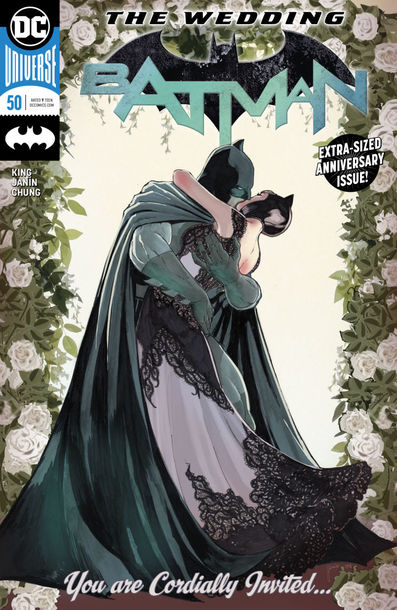 To be honest my initial reaction to turning the final pages of the greatly anticipated Bat/Cat wedding issue was deflated. Spoiler alert: Selina decides she can’t go through with the wedding and Bruce is left alone on a rooftop and it is strongly implied that Bane is ultimately responsible for the aborted nuptials. I’m not sure what I wanted from this issue, and while I can reason out Tom King’s logic for not allowing the Bat and the Cat to tie the knot I suppose what I’m most frustrated by is the titillation. Let me explain. If we trace Bruce and Selina’s fourth quarter, hurry up courtship, back to its origin in the series, it comes out of ‘The Button’ story arc’s resolution of the Flashpoint continuity in Flash no. 22. That universe’s Batman, Thomas Wayne finally communicates to Bruce his desire for his son to find some way to be happy and tries to express to him that his quest for vengeance as Batman is not something his parents ever wanted for him or expect from him. Two short issues later Bruce proposes to Selina. Now from the jump this move raises certain red flags, flags that I initially overlooked in my excitement to see the two married. Bruce reaching out as a gesture of vulnerability and intimacy in his proposal to Selina shows a side of the Dark Knight that seldom sees the light of day, and the characterization offered by the issues that followed the ‘War of Jokes and Riddles’ flashback arc outlining the importance of the other relationships in Bruce’s life were poignant and moving. However, the fact that Bruce’s first instinct to ‘try to find a way to be happy’ as his father suggests is to find happiness in a relationship is wildly problematic. The consequent codependency suggested by that plan pointed to a partnership that could never truly be a partnership, as Bruce’s belief that an outside force could be the key to his own happiness would unfairly unbalance the support structure of the relationship. This marriage could never be maintained with that undercurrent of codependency. Also, the argument that Selina offers Bruce in her letter, that their potential marital bliss could lead to the end of the Batman as we know it is also a valid point to make. Bruce has never been truly happy, and neither we as the audience or Bruce himself know if Batman exists if Bruce is happy. So, my dissatisfaction with the outcome of the issue does not stem from a conflict in the logic of the two not going through with the marriage, but rather with the way King uses the hypothetical marriage of the two in his story. Now, as I read the lead up and prelude to the wedding issues what really interested me were all of the trappings of the hypothetical wedding ceremony to come: Who would be best man, what the parties both bachelor and bachelorette would look like, and how would Joker try to ruin the ceremony. And as we came closer and closer to the fateful day all these sweet little components were assembled: Catwoman stealing her wedding dress, Bruce and Clark Kent’s revelations to Selina and Lois about how deeply they respect each other and the utterly bro-mantic double-date they share with the women they love, and Dick Grayson’s understanding of Bruce and Clark’s friendship and his contentment rather than jealousy with the notion that Bruce might choose the Man of Steel over the Boy Wonder as his best man. I dreamed of a line of former Robin groomsmen in their tuxedos on one side of the altar and a chaotic tangle of villains on the other with Damien serving as ring bearer and a manic Joker officiating sporting a priest’s collar and all. Now my supposed expectation for what King’s Wedding issue was to be is no basis for criticism of the actual event (or lack thereof), but I’m still struggling to encapsulate the exact frustration I’m experiencing with regards to issue 50. I believe it stems from a primary mis categorization of terms that would be on the one hand uniquely clever from a narrative point of view (if they were intentional of course) despite the unsatisfying end reached or a cheap ploy banking on fan fervor and sensationalism. I’m talking about the Wedding itself. My understanding, and I don’t believe it to be a false one, of the literary concept of a Wedding is as an event, as the central focus of a scene, subplot, or entire story and when Bruce knelt down on that rooftop in issue 24 that’s how I framed my expectations for the story to come. The way King uses the Wedding is not as an event, but as a setting instead. The Wedding never occurs, but the deeper exploration of characterization and the events that led up to the hypothetical Wedding can only take place within the narrative wherein the Wedding is going to happen. The setting, or perhaps, narrative context that the impending nuptials creates is the only place in which the character-driven storylines, specifically those involving Bruce’s relationship with Clark Kent, Talia Al Ghul, and the Bat Family and Catwoman’s relationship with the villains of Gotham City can occur, but it is not necessary for the Wedding to ever occur in order to tell those stories. This is really quite clever. But, and this is the thing that really frustrates me, the Wedding as Event and the fervor created by the notion of even a hypothetical wedding between Batman and Catwoman and the long-term implications of that event for those characters seem like a cheap ploy to garner interest and excitement banking on a deliberate mis categorization of terms. 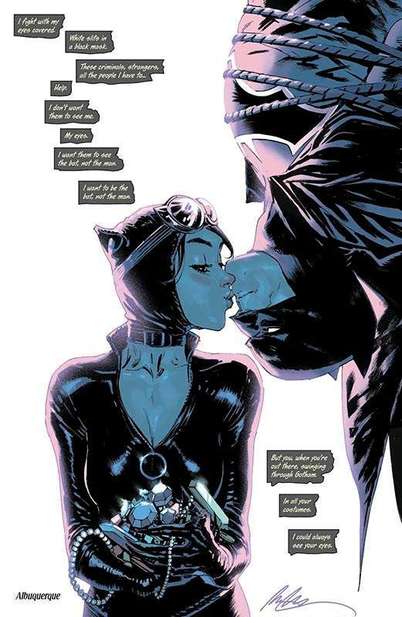 Within the first page’s panels of issue 50 Tom King undermines expectations of the Wedding as a traditional ceremony as Bat and Cat agree to a rooftop rendezvous with a single witness apiece and a drunken judge officiating. No Wedding party, no reception, no gifts, no pomp no circumstance. What the issue actually explores is beautiful in its own way but the initial disappointment, dissatisfaction felt when we realize that no wedding is going to take place is a sizeable hurdle to overcome in order to appreciate what King actually does, rather than what he primed his audience to expect. Now no author can control what their audience will blow up or fixate on as they set up a storyline, but the set-up in this case is a bit ridiculous. It’s been just over a year since the proposal issue of Batman no. 24 and in that time, we’ve been treated to an 8-issue deviation for the ‘War of Jokes and Riddles Arc’ (which I can’t complain about too much having loved that storyline) but also 5 Wedding Prelude issues and a wibbly-wobbly, timey-wimey Booster Gold Arc. Now I can’t say that the blame is entirely King’s in this case, and I understand the desire to give the Wedding issue an iconic issue number, but this ‘tune in next year’ marketing strategy is becoming more of an issue, especially for DC Comics. Take the Rebirth/Doomsday Clock release schedule for example: DC Rebirth 1, with its iconic Dr. Manhattan tease at the end was released May 25, 2016 but the first real threads of the larger DC/Watchmen crossover to come didn’t show up in the comics until ‘The Button Arc’ on April 19, 2017 with Batman no. 21. That’s 10 months, 20 issues of every DC hero book before picking up the threads of that monumental tease and after that we got a 4-issue crossover arc that focused more on wrapping up the loose ends of the Flashpoint Event than providing any more details on the Watchmen crossover. Then readers had to wait 6 months for the November release of the first issue of ‘Doomsday Clock’, a 12-issue mini-series that’s been plagued by delays and shifted to a bi-monthly release schedule, so instead of being 8 issues in as was planned, issue 6 won’t be available until the end of August. Now no one can predict creator delays, and I would much rather have an issue mulled over and perfected over one that was rushed to press, but I'm not sure what logic DC are subscribing to with these extended hype campaigns. They don’t end up sustaining reader interest which would be a valid marketing strategy. Instead they set up wildly unachievable expectations and inspire only reader fatigue as tiny seeds of a storyline are spread across 6-12 month periods. Now all that being said, this is a landmark issue in the history of Batman and Catwoman’s relationship, (I am tempted call it the definitive issue of the relationship) and will inform much of how the characters are written from now on. King manages to pull off a pretty monumental reversal in this issue. Previously, Bruce has always put the mission before everything else; his friends, his surrogate family, his own life. At the end of his letter to Selina we see Bruce’s desire and consequently his ability to become greater than his mission, and it’s Selina’s letter than bends to the power, the will of the Batman’s crusade. She is the one who sacrifices their possible happiness in order to keep the Batman intact. It’s not out of fear, or flightiness, out of selfishness, or insecurity; Selina leaves Bruce on that rooftop because she understands that Batman is greater than either of their feelings. Previous to this issue it was always Bruce’s commitment to the crusade which prevented him from pursuing intimacy, but in this issue, he sees the power of what he’s created as it has become too essential to Gotham for Catwoman to do anything to jeopardize it. I would also be remiss to not mention what I considered to be uncontested highlight of the issue: the artwork. As we read the letters sent between Bat and Cat, 21 artists lend their pencils to cataloging the ups, downs, leaps, and bounds of the pair through their shifting styles over the years of their courtship. As each artist encapsulates a different era, style, or stage in their relationship, you watch as the decades long game of femme fatale and dark knight unfolds, deepens, and becomes intimate. Analyzing each of these page length masterpieces could fill an article all its own, but if I were to just mention my personal favorites I’d say that I never grow tired of Frank Miller’s Catsuit, the not so subtle smirk in the final panel of Tim Sale’s page was refreshing in its boyish charm, Rafael Albuquerque’s is playful and beautiful, and finally Lee Weeks’ stark minimalist page is breathtaking. In summary, while iconic, essential, and clever, issue 50 is ultimately underwhelming and unsatisfying as a result of poor marketing and King’s leaning heavily on and then undermining the mis-categorization of the Wedding as an event rather than a narrative context. The artist’s brought their A Game in tribute to the body-suited beaus and their contributions to this iconic issue will not be soon forgotten. Until Next Time, Geek On! Written by Joel T. Lewis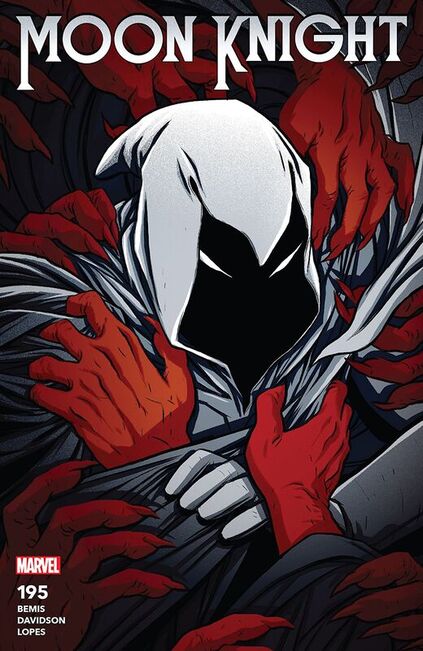 My first look at Paul Davidson’s artwork in issue 195 of Moon Knight inspired confusion. I recognized the characteristic pastel pallet of colorist Matt Lopes, but for the first 6 pages of the book I couldn’t be sure I had picked up an issue of Moon Knight. The sinuous hipster characters seemed better suited to a Boom Studios or Image title than Marvel and I was unsure what to expect from such a stylistic departure from the way I had seen Moon Knight Comics in the past. Fear not dear readers for I had only to turn to page 7 for this issue to cement itself as one of my favorite Moon Knight comics of all time! Issue 195 sees the birth of a new Moon Knight foe in the Collective, a jumbled hive-minded behemoth formed by an unlikely group of misfits who desire to escape the shackles of individuality. This disturbing hurricane of fleshy foibles absorbs everyone it touches adding them to the tangled mass of souls that make up its sublime and grotesque body. Marc, enjoying some much needed mental and physical downtime, is alerted to this new threat’s presence while out seeing a movie with Marlene and Diatrice in reality, and fishing with Khonshu, Steven, and Jake in his mind. Despite just having voiced his contentment to leave the real freakish villains to the likes of the X-Men, Marc dons the Jet and Silver and snaps into action. Marc quips and kicks his way through a short-lived battle with the vastly overpowered Collective before being absorbed into the hive mind himself (or selves if we’re being particularly cheeky) and the issue concludes with Marc, Steven, Khonshu, and Jake faced with the technicolor acid trip that make up the Collective’s collection of psyches. This new villain (which takes broad strokes inspiration from the entity of the same name made up of all the depowered mutants following M-Day) is wacky, grotesque, and perfect for facing off with Moon Knight. Bemis has fast tracked another story arc that gives mental and physical confrontation equal time and it’s brilliant. I love seeing Khonshu in fisherman’s regalia, in fact I’ve taken to referring to him in that getup as ‘Step-Dad K-Man’, I love the back and forth commentary on leaving Sun King alive between Marc and Jake, and I especially love Diatrice’s request for Sour Patch Kids as Spector leaves the theater. As well-crafted and clever as this issue is written, for me this month’s installment is all about the art. From the pink haired, tattooed and mustachioed members of the Collective, to Fisherman Khonshu, and finally to the sharp fluidity of Moon Knight himself, Paul Davidson is drawing his ass off. Davidson’s Moon Knight is a sinewy, expressive design, sporting a belt that splits into two short swords and it just looks cool. The first panel we see of Davidson’s Moonie springing into action with his cape balled in his fist is stunning and a design all his own. Set in sharp contrast is the whirling pink mass of the Collective, whose towering chaotic design is revolting in the best way. Watching these two figures dance from panel to panel as they fight in the Hall of Science toppling T-Rex skeletons and dodging Helicopter machine gun fire is incredible and the final image of swirling nightmare of the Collective swallowing up Moon Knight is one of my favorite images in comics. Paul Davidson will return in issue 196 before concluding his brief run on Moon Knight, and while I would love him to stay on as a regular, I’m very grateful to have another issue to read where he will be drawing our favorite lunar vigilante. Until next time, Geek On! Written by Joel T. Lewis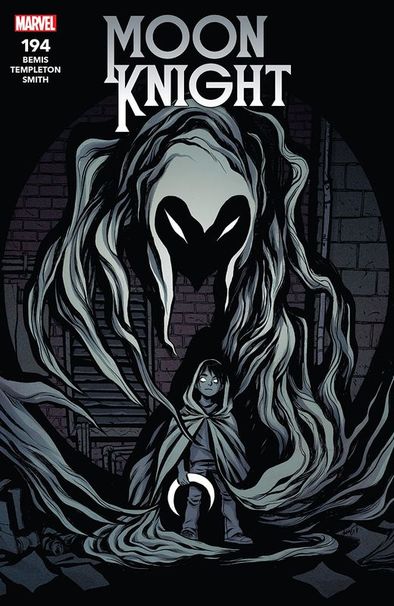 We all know the Origin of Moon Knight, or if you didn’t and you’re reading this, chances are I’ve reiterated it to you a dozen times in reviews passed and you have grown sick of reading about it. Marc meets Bushman, Bushman stabs Marc, Corpse meets Khonshu, Marc becomes Moon Knight. We’ve seen it replayed and reimagined over the years, but something we’ve never hammered out for sure, is the origin of Marc Spector’s Dissociative Identity Disorder. With issue 194, author Max Bemis takes a shot at the trauma that gave birth to Steven Grant and Jake Lockley when Marc Spector was just a boy. Taking broad strokes of inspiration from the 1998 Bryan Singer film Apt Pupil, issue 194 recounts the story of young Marc Spector discovering that a longtime friend of his father’s, adopted Uncle Rabbi Yitz is in fact Ernst, a Metahuman Nazi War Criminal whose unnatural long life comes from torturing and killing Jews. Marc’s discovery of this friend of the family’s capacity for violence and cruelty is what Bemis, and by extension, Marc credit as the traumatic lynchpin for Marc’s creation of Steven Grant and Jake Lockley. Marc confides this story to Frenchie as a way of exercising the demon of that trauma in preparation for explaining his disorder to his daughter Diatrice. Bemis leans hard on Marc’s Jewish upbringing and the influence that Jewish humor and the religious Elder community had on Marc at an early age. This was a tense read for me, as I braced myself for the very real possibility that Marc’s Disorder might have come out of sexual abuse. Relief is an odd word for what I felt when it was revealed that Ernst was a Nazi serial killer and psychopath rather than a pedophile, but there it is. Bemis boldly juxtaposes the flashback of a blood-covered Ernst explaining to Marc for the first time, what the Shoah (Holocaust) was and his role in it with images from the present day depicting Marc, Marlene, and Diatrice in the most domestic and happy panels ever to appear in a Moon Knight title. The weight of this description, the depth of the cruelty and horror of the holocaust hits Marc all the harder for having finally achieved some semblance of a family unit, a base of comfort and love that the thought of having ripped away would be unbearable. Ernst and this storyline feels as if they were lifted right out of the final arc of the first run of Moon Knight wherein a group of Cabalist mystics abduct and raise from the dead Marc Spector’s recently deceased father. For Marc’s first enemy to come from so intimate a position in his life, to be so subtle and vaguely super powered as Moon Knight is himself, and for him to have disappeared so suddenly following Marc’s confrontation with him all those years ago sets the stage for a present-day return of the False-Rabbi Ernst and a showdown that will carry more weight than any that has come before. This is a really well executed issue, and while I am suffering from the origin fatigue that afflicts many of us in nerdom, this origin was paced, framed, and developed appropriately so that it felt fresh and necessary. Though artist Ty Templeton didn’t draw much of the jet and silver avenger in this issue, the tension between the violence and cruelty of Ernst and the calm domesticity of Marc’s new family is accentuated by his clean, cartoonish style. This contrast is as much the triumph of colorist Keiren Smith, whose transitions in lighting and color scheme really leap off the page. Bemis continues to deliver a comic that feels like the Bronze Age in the modern day and if he continues to use Moon Knight to quote Seinfeld (as he does in this issue) I will buy his issues forever. Until next time, Geek On! Written by Joel T. Lewis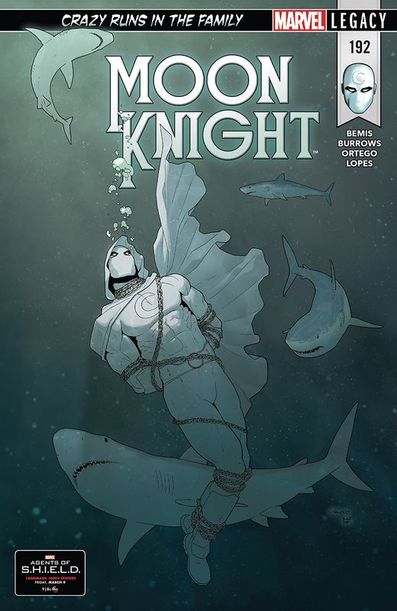 It’s difficult to describe where I am with Max Bemis’ Moon Knight. To be honest I’ve been considering concluding my coverage of this series with the ‘Crazy Runs in the Family’ arc but I can’t really explain why. Am I enjoying the series? Absolutely I am, but I’m not sure I can write about it in an objective way anymore because despite its flaws I have fully bought into the spirit of it. Let me try to explain. If we trace the history of Moon Knight through its many phases (ha! Moon Puns) each left their unique mark on the character; the original series explored ghoulish enemies and Marc’s bizarre psychology with the quips and tone befitting a Bronze Age comic. ‘Fist of Khonshu’ tried to reframe the character as the literal errand boy of a group of Egyptian Priests, Marc Spector’s Moon Knight dropped the multiple personalities, added and then removed a sidekick, and then went absolutely nuts in its last 5 issues. Huston brought us gore and violence and vengeance, Hurwitz gave us resurrection and Deadpool, and Bendis tried to lay the groundwork for another one of his trademark breadcrumb storylines but ended up writing more about Spider-Man, Wolverine, and Cap than Moonie in his run. Warren Ellis boiled Moon Knight to his essence, gave him a sick new costume, and a run of episodic one-shot adventures. And finally, Jeff Lemire shattered all expectations for what the character meant and could be by intimately exploring Moonie’s psychology. Every run has left its mark on Moon Knight, all of them have taken queues from or written away from those runs that preceded them, and each generation of the character was unique in tone and purpose regardless of their success. Now I’m going to make a bold statement here and I’m sure it will send those anti-Bemis readers of mine into a tizzy. While trying to identify where Bemis’ series fits into the larger Moon Knight Legacy I’ve found that the closest analog in spirit is Doug Moench’s original series. Bemis’ run is as unpredictable, at times convoluted, and ultimately as fresh as the best Moon Knight issues from the early 80’s. I understand that for a modern series to take so many queues from the Bronze Age of Comics (1970 - 1985) is quite bizarre and honestly I believe that is the very reason that this series is as divisive as it is. The book is so unfettered and flexible that it can be so many things at once and that makes it dizzying trying to pin down a method for analyzing it. Is it wordy? My god yes it is. Is it the best comic series that I’m currently reading? Not by a long shot. Is it the most fun? I have to say yes. Bemis’ run isn’t silly; there’s far too much violence and trauma to allow it that description. But it is undeniably wacky, and that’s not a quality that comics have anymore. You wouldn’t call the post-modern, format-dashing, fourth-wall shattering acrobatics that the Deadpool comics pull off every month wacky. Irreverent sure, punk rock undoubtedly, but never wacky. And it’s this wackiness that I’m finding hard to properly critique. These issues are flawed and have their share of awkward moments but they feel like that original series and it is in that spirit that I offer up my review of issues 192 and 193. 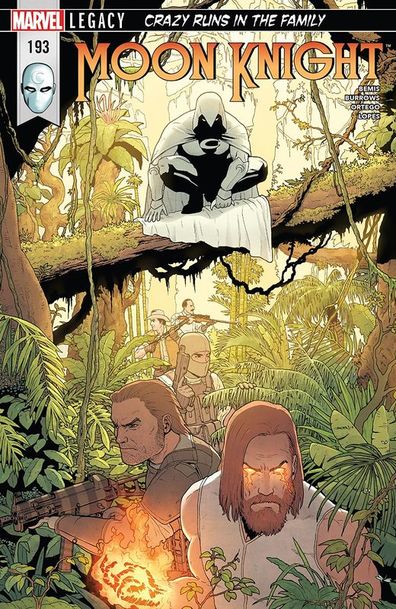 First of all, fear not, Frenchie’s not dead. His undead exterior was merely a hallucinatory holdover from when we last saw him in Lemire’s run. Babysitter acquired, Marc is accosted by Bushman, the Truth, and the merry band of maimed street thugs assembled by the Sun King. Marc agrees to go quietly away with this motley crew in order to guarantee Diatrice’s safety and to try and save Marlene. Unable to resist the opportunity to torment our hero, Bushman provokes Marc who leaps into a visually stunning display of boat deck brawling. After cutting off two of Bushman’s fingers and dispatching the crew of the ship, Marc discovers a huddled mass of lost men, women, and children lured by the Sun King’s promise of an island all their own; a place where they could change the world together. Moon Knight is welcomed to Isla Ra by the Sun King who’s definitely taking his wardrobe queues from Jeff Probst (longtime host of Survivor) and the two settle in for a fireside psychedelically inspired philosophical discussion. Ra then makes his case from within Marc’s own mind, contextualizing the futility and ultimately harmful impact of Moon Knight’s vigilantism with hypothetical rebrands of the jet and silver avenger. In this trippy sequence we see Moon Knight as the herald of Galactus, Moonie inspired Sentinels, and Steven, Marc, and Jake in lab coats talking to the Fantastic Four before their accident and issue 192 ends with Marc proclaiming that Ra might be right. In issue 193 Marc is beaten, branded, and humiliated before the forgotten masses assembled by the Sun King all leading up to one final showdown on a moonlit beach in the center of a ring of fire. The brutality of this abuse intersects with some very sweet panels showing Diatrice earnestly praying to Khonshu to help her father. But all of this is merely the interlude to an epic smack-down of a fist fight where Marc, trading fists with flames, is beaten just about as badly as he’s ever been. While the Sun King picks apart Marc’s exterior, Jake, Steven, and Khonshu debate the reality of their existence within Marc’s head, their inability to help him, and the power that the Sun King has derived from his conviction, his absolute faith in Ra. Khonshu explains that the Sun King’s powers and his belief are as powerful as the different persona’s fatherly affections for Diatrice. This leads to a sort of clunky, but ultimately satisfying conclusion that Steven Grant puts like this, ‘Are you saying...if Sun King’s belief is a part of him, and in some weird metatextual way relates to his abilities, that, in a way, Marc has powers of his own?’ Jake then answers Steven’s question, ‘Holy @#$%...We have the power of crazy!’ This mental conviction helps Marc defeat Sun King and the issue concludes with Moon Knight rallying the lost souls tricked by the villain into returning home. Clunky, wordy, and convoluted but entertaining nonetheless. A line from The Lion King comes to mind, ‘Slimy, yet satisfying.’ It’s not a perfect book. But it’s fun. I don’t think that the ‘Power of Crazy’ is all that eloquently or succinctly put but to Bemis’ credit, he does comment on its clunkiness and to be honest, it is as reasonable and vague as every other exploration of how Moon Knight’s powers (such as they are) work. Jacen Burrows’ artwork triumphs once again, especially in issue 192. From the Shark attack cover art to the boat-deck brawl Burrows is a man very much in his element. I will forever be grateful to him for bringing Moon Knight, Herald of Galactus to life, astride his crescent moon glider in that issue. I honestly believe that the range of work present in this first run on Moon Knight is resume enough for Burrows to pick and choose his projects for the rest of his career. There is earnestness in this series and genuine novelty and though it feels like the product of another era of Comics, I believe that’s part of its charm. Until next time, Geek On! Written by John Edward Betancourt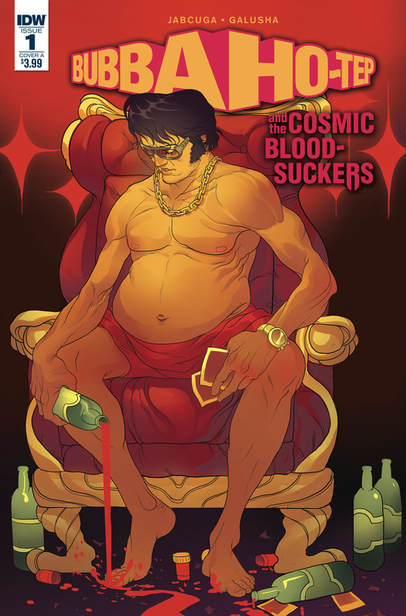 Of the many horror stories that I love and revisit as often as possible, one that continues to find a special place in my heart is the 2002 film, Bubba Ho-Tep. That story, which features Elvis Presley and J.F.K. fighting an evil mummy in a rest home is simply a delight to watch over and over again, because of the fact that it is so original and so unique and quite frankly, so damn perfect. It’s just a magical tale that Bruce Campbell and Ossie Davis sell with their fine performances and well, it’s one that I often think of because of the ‘What if?’ factor. After all, there was, for a time, the idea of a sequel floated about called Bubba Nosferatu and man, how cool would it have been to see Bruce don the Elvis outfit once again to kick some vampire tail from here to Graceland? But alas, that project has yet to come to fruition since there were some creative differences between Bruce and Don Coscarelli when it comes to the script and that’s okay, because it’s best those two men be on the same page over such ideas and also because, what cannot be explored on screen, can be explored in the comic book world. Because after many years of playing ‘What If?’ in my mind, IDW Publishing, and Joe R. Lansdale have delivered unto us, a magnificent prequel/sequel to a magnificent film by way of Bubba Ho-Tep and the Cosmic Blood-Suckers. Now this particular tale takes us back in time to when Elvis was still at the top of his game and enjoying the good life through and through. But the Colonel comes knocking with an all-important mission for the King, one that comes from President Nixon himself in that…there’s an alien threat that has arrived on our world and it will be up to the King and a rag tag group of fighters to deal with this threat accordingly, and well, it’s inherently clear after reading the first issue of this new series, that I, and other fans of this franchise are going to be in for quite the treat. That’s largely due to the fact that this prequel feels organic in every way imaginable. You can hear Bruce Campbell’s voice in your head whenever Elvis speaks on the page, and much like the movie, the story takes its time to allow for us to get to know the characters and build their world properly and holy cow, what a world this comic is building. This book just feels like a classic 1970’s horror film, with monsters lurking around every corner and it includes artwork that quite frankly has that washed out feel of the era and well, it does such a good job with both elements that when the issue came to a close I was hungry for more. If anything, this is it. This is the sequel/prequel fans of this franchise have been waiting for and what matters most, it’s good. It’s damn good, and I love the fact that while this tale feels independent in its own unique way, it found a way to tie together the connective tissue it shares with the film, something that serves as a reminder that we are going to be in for a wild ride, one that will make us laugh and leave us in awe and this is a series that I’ll definitely be following closely in the months to come because the King is back baby, and those blood-suckers better beware… The following interview was conducted by Joel T. Lewis at DiNK Comic and Art Expo 2018 in Denver, Colorado. This interview has been slightly edited for clarity.Let’s remove all pretense for a moment. I was scared to meet Jeff Lemire last weekend at the Denver DiNK Convention. Back when my favorite author was Charles Dickens or Charlotte Bronte I never had to worry about what I would say if I had the chance to meet them. Death has a funny way of preventing those kind of conversations. But after reading his work, Lemire leapt to the top of my list. His compassion, the poignance of his work, and the seemingly inexhaustible stream of new and diverse projects hit me all at once and I had to think about it. What do you say to your hero? To a man who’s made you laugh and cry and made you happy there behind the printed words of a single issue that could’ve been read or written by anybody.
But even then, the thought was merely cathartic fantasy. Sure, it was possible that I could meet him at a signing and have that brief moment of awkward chit chat, with me telling him how much his work meant to me, and him making polite small talk as he signed the issues I sheepishly pushed towards him. But the intimate conversation, the mild interrogation, the fevered gushing that I was planning wasn’t possible. It would never happen. But it happened dear readers. I got to interview the man. I got to sit a foot away from a man whose work spoke to me, shattered me, and put me back together through the thin glossy pages of a comic book and ask him whatever I wanted. He was cool, he was kind, and he was very generous, both with his time, and with the answers he gave me. Here’s what I asked him and what he said to me. I hope you enjoy it. One of the things I really like about your artwork specifically is your character’s facial expressions. They’re very expressive and I was wondering when you start a project with a new character is that where you start? Jeff Lemire - Yeah, it's always faces. It’s the thing I like to draw the most. Usually with a new project it usually starts in my sketchbook and there’ll be a character like Sweet Tooth or something, and you create a little character and you don’t really know what it is and it might start re-occurring in your sketchbook and you start to build a story around them. My artistic style is very unique I think and kind of idiosyncratic and I have strengths and weaknesses. So I kind of play to my strengths and one thing I try to do is communicate a lot of emotion with my characters and their faces. So I think it’s one of my skills so I kind of build around that. For sure, it definitely comes across. That’s awesome. I notice a lot of trinkets in your work. JL - Oh really? Well there’s the stopwatch, or the pocket watch in Underwater Welder, and the vintage radios in Royal City. So, I have a collection of little things like that and I was wondering if you did too, if that’s where that comes from? JL - No, I’m not much of a collector at all. The only thing I really collect is books. Same here. JL - But you know cool little objects like that can tell a story too. It’s not just characters. There’s something about those old radios that just evoked a time and a story that’s kind of supernatural to me you know? I don’t know why. Or that stopwatch. Those just cool sort of old things that have a story themselves, they can be really interesting. You can kind of fall in love with drawing certain little objects, different things that for some weird reason stick around. Very cool. Awesome. So I’m a massive Moon Knight Fan. JL - Oh Cool. So I’ve got to take a second to say your run was spectacular. It meant a lot to me. Issue nine is my favorite comic of all time. JL - Which one’s that? That’s where he reconciles with his other personalities and kind of lets them go. JL - Oh yeah, I like that one too. Where he hugs the one guy. Yeah, it was really cool to see you treat a character I care about so much with such seriousness and compassion. That was really cool. JL - Thanks. So the question I had was: when you’re coming into a character that’s been established and they have this kind of nuanced history, how do you balance your vision for the character’s arc and the history that’s come before? JL - Well usually that history’s really inspiring, and inspires new stories for me. So if I’m working on an existing character from Marvel or DC or something I haven’t created myself, the first thing I’ll do is collect everything on that character. Every run, every story, every comic I can get my hands on and I’ll just read everything and as I’m reading, I get story ideas like, ‘Oh this is a cool idea, but what if it went further with this idea or that.’ So, with that stuff you take advantage of the fact that it has this history that you can use. Especially with Moon Knight, I mean I made his whole history kind of part of the story. Sometimes it works better with certain characters with the idea that you have. Like the Moon Knight idea that I had, that stuff just lent itself to pulling from those different eras and characters. So when you can, that stuff’s a gold mine to use. Even with Black Hammer, those are my own characters but I’m obviously drawing from 80 years of superhero comic book history. Why not use it when you know it’s there? Like I was never a huge Moon Knight fan but I was a big Bill Sienkiewicz fan so I always respected and kind of liked that version of the character. So I started there and then I found other things along the way that I liked. You know for a character that hasn’t really had an ongoing series regularly over the years there have been some really good stories. The Sienkiewicz, (Doug) Moench stuff is obviously classic, it’s amazing and the Bendis stuff was really interesting I thought and especially the Warren Ellis stuff was a great jumping off point for me. He really kind of repositioned things. You know you use all that stuff and you build off of it as much as you can but I mean if you can’t bring your own idea, your own point of view to it then there’s no point in doing those things. I noticed that you did that too with Old Man Logan with the Past Lives run, that was cool that you kind of paid homage to all those tragedies in Logan’s life. JL - Yeah, you try to evoke the feeling of the stuff that everyone loves without just retelling those same stories and you can. It doesn’t always work but when it does it can be fun. Was it always your intention to have several different artists for the different perspectives of Moon Knight? JL - No (laughs) Greg (Smallwood) just kind of got behind schedule. But again, it's one of those things where the story lends itself perfectly to that so just embrace it. Yeah but it really worked out. Greg’s pretty versatile himself. He can kind of do different styles but it was kind of seamless with what we were doing so I kind of got lucky there. Yeah, you got Francesco Francavilla on there which was awesome. JL - Yeah and Wilfredo Torres. And James Stokoe. JL - Yeah we got really cool people on there. So, speaking of collaborations, I love After Death (A.D.). That was such a cool synergy of writing and your artwork. I was wondering how you worked with Scott Snyder and how that writing process was. JL - Yeah, it was really unique and I had never drawn anything before that someone else had written. I had done a couple of short stories that Damon Lindelof had written but those were just 10 pages so it's not like a huge commitment but I’d never done something big like this that I hadn’t written myself. I’d written for other artists but never drawn for other writers so it was really intimidating and we kind of felt it out as we went along. I think Scott really trusted the fact that I also am a writer and visually I know how to tell a story. It kind of just evolved as we went but what it ended up being was Scott would spend the majority of his time working on the prose sections because those were pretty labor intensive for him and while he was doing that I would do the comics sections. And we really didn’t have a script for those. We would just have conversations where this happens and that happens and I would just start thumb-nailing it and drawing the comics. And when there were dialogue scenes I would just try to leave room for dialogue and then draw characters talking and hopefully get it sort of right and then he would go back and letter the stuff afterwards. And if in those dialogues I needed to tweak a facial expression or an emotion to match something he’d come up with I would do that but for the most part we kind of made it work. So it was sort of a unique collaboration. Yeah, it’s such a unique book from those prose sections and then you have panels and panels with no dialogue. It was really playful. I loved it a lot. You’ve gotten to work with a lot of great artists, great writers: Andrea Sorrentino, is outstanding, Gideon Falls is really good, Smallwood on Moon Knight, so I was wondering if there was somebody in the industry you haven’t gotten a chance to work with past or present, living or dead who that would be? JL - Oh boy, so many. I don’t know. There’s so many amazing artists it’s hard, oh god there’s so many! One guy that I’ve always felt like I really wish I had done more with was Rafael Albuquerque. We did a few Animal Mans together at the end of my run and we really clicked. I felt like we really had something, so I felt like he and I had like a similar sensibility kind of like the same way Dustin (Nguyen) and I had a similar sensibility. I feel like he and I could do something special together, but our schedules have never worked out so he’s someone I’d like to do something with someday. But I mean there’s dozens of artists just working today you know I’m drawing a blank of course but there’s so many talented people out there. Do you know if, I know its early stages, but you were talking about a collaboration with Matt Kindt, do you know if you would draw, or if he would draw? JL - No, we were both talking about that this morning, I think we decided we’re just going to write it together and we know what artist we want to work with. Because we both have so many projects already lined up that we’re drawing we know that if we waited it might never happen and we want it to happen. Another question I had specifically about your work, is you have a lot of characters under water. There’s a lot of submerged kind of cold moments. JL - It’s like a definite motif. Yeah, so I was wondering what inspires that? JL - I don’t know. It’s just subconscious. I just love being underwater. I always have since I was a kid. There’s just something so peaceful about it. Whenever I can I love being in the ocean. So I’ve always had this weird connection to that and I don’t know, symbolically I think water is so rich. It can mean so many things, life, death, rebirth, and I love drawing it. It’s just a weird motif that I’m drawn to. I try not to overthink it. Because when you start over-analyzing stuff sometimes it can go away. But yeah, it’s definitely a motif in a lot of my work. You know surprisingly not a lot of people have pointed that out. I mean it's in Royal City, Underwater Welder especially, it’s all over that stuff. That was something about After Death (A.D.) that I noticed: that even though it was Scott writing, he talks about the ice over water and it always being there. So it felt like you were writing it too in that sense. JL - Yeah, I never thought of that but yeah it’s definitely something very symbolic and I think it probably started with the Welder. But even in Essex County there were scenes where the old man would walk out into the water and sink below. So I’ve always been kind of drawn to that. So, you’re going to be on Sentry soon. JL - Oh yeah. Which is really exciting for me as I’m a big fan of the Jae Lee stuff and Paul Jenkins. It’s kind of like you’re cherry-picking all of my favorite characters it's really cool. Do you know when that process will start? JL - I think the series starts in June. I’ve written four of them and I know Kim the artist is finishing up the first issue so it’s coming along. I think I was reading something you were talking about him (Sentry) in contrast to Moon Knight, about kind of the cerebral nature of their madness. JL - Yeah, well they’re both characters that suffer from mental illness, but I didn’t want to just redo the Moon Knight story you know because it’s a different character, it’s a different illness, different way of seeing the world, different history. But I think there is a little bit of a link between the two in the way that I’m approaching it. But I want to tell a Sentry story that’s a Sentry story the way the Moon Knight story had to be a Moon Knight story. Do you know if it's going to be on-going, or is it going to be 14-ish issues or? JL - I’m not sure. I don’t know how long my run will be on that to be honest with you. I’m so busy right now so I’m definitely signed on to the first arc, and then we’ll see from there where it goes. So I just have some rapid fire ones here to close out: What if any comics are you currently reading? JL - My favorite kind of ongoing book is Paper Girls. I love Cliff (Chiang)’s art so much. There’s a lot in that series I just find very entertaining and I like that a lot. Nate Powell has a new graphic novel coming out called Come Again which, it’s not out yet, but I got to read an advance copy and that was fantastic. I always read Matt (Kindt)’s stuff. He’s always doing great stuff. Of the more mainstream-y superhero stuff I don’t read a lot to be honest but, I try to keep up on Jason Aaron’s stuff because I really like Jason’s writing a lot. Mighty Thor’s been outstanding. JL - Yeah, his superhero stuff and his creator-owned stuff is always so strong, he’s just such a great writer. I follow more creators around. Those are the ones that pop in my head of the stuff that I’m into right now. If there’s a single issue or series that you’re most proud to have written what would that be? JL - That I haven’t drawn myself? Yeah, that’s tough. I sometimes look at that stuff and sometimes it’s hit and miss you know. Some things work better than others. I don’t know if I could pick one, but I think the ones that I’m most proud of would be Green Arrow with Andrea (Sorrentino), Animal Man, Moon Knight, and my Bloodshot for Valiant. Those are probably the ones that pop up. I mean that’s not counting any of my created stuff. Obviously Black Hammer and Descender are much more dear to my heart than any of that stuff. I'm just thinking of the more freelance work I’ve done, it would be those runs. So same question but with drawing. JL - That’s tough too. To me they’re all like documents of where I was as a person when I was doing them so they’re all special to me in different ways. You can’t pick one you know but, I mean Essex County was sort of like the first project where I found an audience, where I found a voice as a writer. So it’s always going to be special to me. Sweet Tooth’s always going to be special to me because that was the longest project I ever did. It’s like four years of writing, of drawing those characters everyday so they’re always dear to my heart. And it’s usually whatever I’m working on now is like the thing I’m most engaged in so that’s like my favorite. Yeah it’s hard to pick between that stuff. What’s the strangest request for a commission that you’re ever gotten? JL - Oh god. (laughs) I don’t do a lot of commissions anymore. I haven’t done them in about ten years but I used to get some weird ones. It’s just weird where you know my art style is so specific and you’ll get people will ask you for something that clearly like plays against all my strengths. If you can ask me for all the things why would you want like, whatever, Donna Troy? I’m not going to do a good beautiful woman you know. Sometimes you get some pretty weird, infamously weird commission requests that all artists get from these certain people all the time that are like these weird kinky things. So there’s some strange ones. And just the last one: if someone was new to comics, and wanted a starting point what would you recommend? JL - The two entry points for all my work always over and over I always say are Sweet Tooth and Essex County. I guess one of those. Those would be my starting points for my stuff. Written by Joel T. Lewis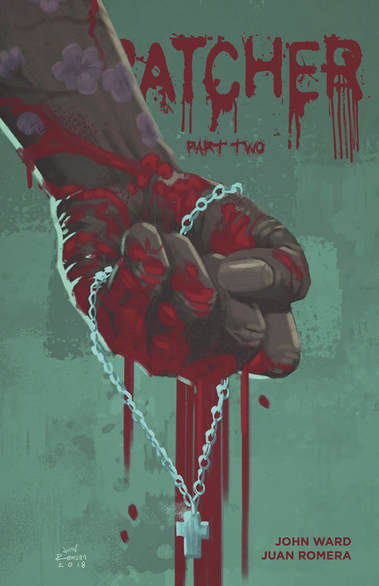 There have been a lot of Horror Comics. There have been a lot of independently published Horror Comics. But there hasn’t been a comic quite like Scratcher before. John Ward and Juan Romera deliver a story that manages to be unique, familiar, and fascinating all at once. Scratcher is what you’d get if you took Evil Dead, swapped Ash out for a badass, lesbian tattoo artist of color with a strong sense of pride, responsibility, and enough demons on the inside to match the ones she faces on the outside. The premise of Scratcher is exceptional in its simplicity; a tattoo artist tracks down her old clients that have become possessed by the tattoos she gave them. What a unique delivery system for mayhem! And this is the critical element with Horror: innovation. How many zombie, vampire, possession, or slasher premises have we seen recycled and rebranded over the last 15 years across all mediums? What keeps us jumping in fright and fascinated by fear is surprise, and when a creator is able to breathe new life into a genre with something as surprising as demon tattoos that’s exciting! That’s what Scratcher brings to the table; it’s wildly refreshing. Now I would like to say at this time that this is a Spoiler Free review of Part 2, but I will not refrain from spoiling elements from Part 1, so if you haven’t read the first issue (and you really should!) please do so before continuing. We catch up with Dee Wilson as she arrives in Los Angeles to track down Jerry Jones, one of her 3 remaining clients. She finds Jerry preaching in a derelict church to an usual audience of garbage. After having her offer of assistance violently rejected by the deteriorating priest, Dee teams up with a mysterious molecular virologist who has a theory that the people Dee tattooed are suffering from a nano-virus introduced into their systems by the tattoo ink. This unlikely duo proceeds to track Jerry down in order to obtain a tissue sample from him and stop him from committing further acts of horrific violence. The Scratcher comics are brisk and you get your money’s worth. Reading over the issues I was impressed by the amount of ground Ward was able to cover in only 28 pages. Where I could easily see DC or Marvel milking the narrative beats of this issue out over 2 or 3 months, throwing multiple last panel cliffhangers, I found myself pleasantly surprised that each issue of Scratcher gave me more actual story than I anticipated. This issue was action-packed and the twist Ward leaves you with really opens up the world he’s created. Juan Romera’s artwork leaps off the page, almost a combination of Francesco Francavilla and Jeff Lemire’s work but with an exceptional eye for shadow and facial expression. The comic is gorgeous and the way Romera directs the eye from panel to panel, page to page, is incredible, subtle, and compelling. The cover art for this issue in particular is spectacular. It’s juxtaposition of the cherry blossom tattoos with the gore dripping from the closed fist and the imagery of the crucifix is very evocative. I was also impressed with Romera’s rendition of the iconic Griffith Observatory. The detail, shading, and shadow work is really quite breathtaking, especially with such a unique and recognizable landmark. This is a series to add to the pull list dear readers. It’s brilliantly executed, refreshing, and layered and I cannot wait for Part 3! Until next time, Geek On! Look out for Scratcher: Part 2 on Comixology in April! Special Thanks goes out to John Ward for providing Nerds That Geek with an Advanced Copy of Scratcher: Part 2! Written by Joel T. Lewis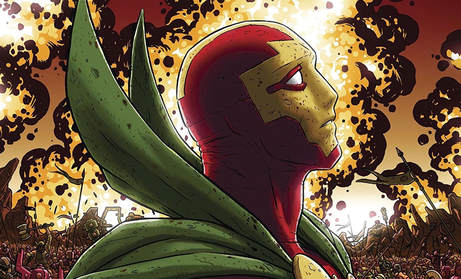 Mister Miracle is a special book, but I can no longer find that surprising. Special books are what you get from Tom King. He took Dick Grayson in a new direction with his spy series Grayson, he reshaped how a lot of us think of Marvel’s Vision in his brilliant 2 volume series, he’s breathed new life into the post Rebirth Batman series, and finally there’s Miracle Man. Look, if you know anything about me from my effusive Moon Knight reviews, or the Movie Mumble Podcast, you are aware of my tendency to discover an author, actor, director, character, aesthetic, what have you, and subsequently devour every little thing that I can about it. It’s almost a compulsion I have, it’s as if by discovering this avenue of content I was unaware of I’ve opened a chasm of desire, a hole in myself that I didn’t know needed filling that I have to fix. I discovered Tom King through the Batman/Flash Crossover Arc ‘The Button’ which was the first real thread of the Watchmen/DC crossover event that was introduced by the Rebirth reboot of the DC Universe. And while I had come to that arc in particular to see what DC were going to do with the daunting task of merging these two comic book universes, I was struck by King’s tenderness when it came to Bruce Wayne. For a little bit of context, in the ‘Button’ Arc Flash and Batman travel to a parallel timeline (created in the DC Flashpoint event) where Bruce Wayne was murdered in that alley instead of his parents, and as a result, Thomas Wayne becomes a twisted foil of Batman and Martha Wayne becomes the Joker. The way that King handled the meeting between father and son across the chasm of time and chance was heartbreaking, generous, and tender, and it was this treatment of a character I love so dearly that brought me back to that series for the following 15 issues. I then picked up King’s outstanding and eerie Vision series. The bizarre charm of King’s domestic drama starring the animatronic Avenger is something you simply must read to believe. From the opening panels depicting the Vision family’s jet-propelled mailbox to the escalating violence and mystery that develops throughout the 12 issue series, King strikes a balance between the uncanny and the innocent. I was mesmerized as Vision and the android family he built for himself, failed to live up to the domestic expectations of middle class suburbia. Reading that series was like eating a Twilight Zone cake: ominous and delicious. Now out of that Batman series nearly every issue was a gem, particularly King’s Batman: Elmer Fudd issue, the whole of the ‘War of Jokes and Riddles’ arc, and the ‘Proposal’ issue, but the story that really stood out for me happened to be issue 23 ‘The Brave and the Mold.’ Now I did write a review of that issue for Nerds That Geek back in July of 2017 so I won’t go into too much detail about it, but it’s probably in my top five issues of Batman ever. Spectacular title, great cover, a Swamp Thing team-up: it has everything. But it also happened to be a one-time collaboration between Tom King and Mitch Gerads, whose work just compliments each other brilliantly. That’s not to say that King hadn’t collaborated with wildly talented artists before this; with talents like Clay Mann, David Finch, Jason Fabok, and Mikel Janin on Batman and Mike Del Mundo on Vision, King is no stranger to seeing his work brought to dazzling life by a brilliant artist. But something was different about the team-up between Bats and Swampy, King and Gerads, and I remember thinking, ‘Man, if they gave these guys their own series together I’d be in on day one.’ Turns out DC decided to give them their own series: Mister Miracle. And it was so popular that the first issue sold out so fast that I had to wait for the second printing before I could read it. The reason I haven’t been reviewing this series issue by issue is that I’ve had difficulty putting my admiration into words. One of the invigorating habits of the comic books in my life has been their ability to make me passionately invested in characters I knew nothing about, or couldn’t have cared less about, within the first few panels of a single issue. Christian Ward and Saladin Ahmed did it for me with Black Bolt, Jason Aaron and Russell Dauterman did it with the Mighty Thor, and King and Gerads have done it for me with Mister Miracle. Their startling fresh take on one of Jack Kirby’s New God’s characters, the master escape artist Scott Free has been the comic I’ve been most eager to crack open every month, and the recent sabbatical that the creators took between the two arcs of their 12 issue series was almost unbearable. It’s stunning, it’s tragic, it’s important. There are a number of ways to navigate your way through the wide world of comics. You can follow a character, a storyline, an artist, or if you choose to follow an author, you won’t be disappointed if you start with Tom King. Until next time, Geek On! Written by John Edward Betancourt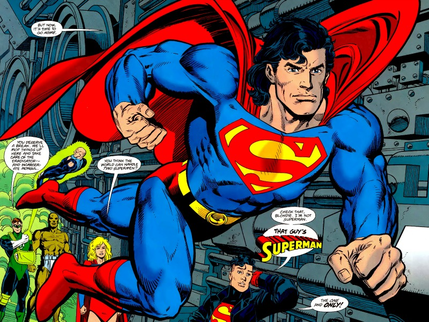 So, it came to pass, the Last Son of Krypton, the world's greatest protector, a man made of steel had fallen in the streets of Metropolis, defending it with his life. The world was stunned, and all would mourn the passing of Superman, but his death...was only temporary. Yes, the Return of Superman was the only logical plot line to follow his death and DC Comics pulled out all the stops in telling such a tale. Following his demise at the hands of Doomsday, the Man of Steel is entombed within a shrine and the world seems to be a worse place without him. But in his absence, there seems to be a flicker of hope as four men, each bearing the seal of the house of El upon their chest step in to save the day, and their arrival will make the world a vastly different place. I have to admit, the entire story of how Superman returned, was to me, as compelling as the story that came before it. We had no clue who might have been the real Kal-El when it came to this ‘Reign of the Supermen’, minus of course Steel since John Henry Irons was born on earth. But the other three...well, they all looked like the Man of Steel, and flat out had his genetic makeup and it made for some incredible storytelling. After all, the storyline did a fine job of slowly revealing the true origins of these Supermen and I loved that the Cyborg, who appeared to be the true reanimation of Superman at first, turned out to be one of the nastiest villains out there. After all, destroying Coast City and murdering seven million people in order to build an engine is pretty damn cold blooded. Oddly enough, my brother and I were split on who was the real Superman. My money was on the Eradicator since he seemed like a man who had dealt with death and my bro was all about the Cyborg and well...we were both wrong. Since it turned out the real Kal-El was healing inside the Fortress of Solitude all this time. Either way, this was a story arc that completely pulled me in. I not only wanted to see Superman return badly, but I could not wait to see how he came back to life after being devastated by Doomsday. Of course, the story between Doomsday and Superman wasn’t quite wrapped up just yet, but we will visit that another day, down the road. |
Archives
May 2024
|
|
© 2012-2025, Nerds That Geek LLC.
All Rights Reserved. |
uWeb Hosting by FatCow

